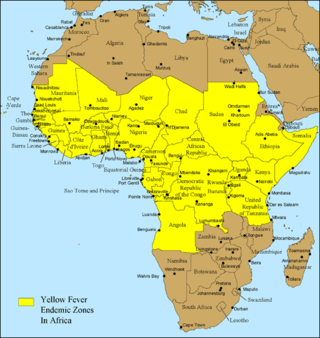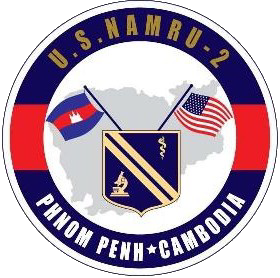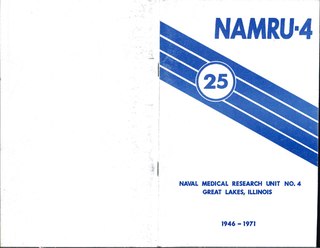
Arbovirus is an informal name for any virus that is transmitted by arthropod vectors. The term arbovirus is a portmanteau word. Tibovirus is sometimes used to more specifically describe viruses transmitted by ticks, a superorder within the arthropods. Arboviruses can affect both animals and plants. In humans, symptoms of arbovirus infection generally occur 3–15 days after exposure to the virus and last three or four days. The most common clinical features of infection are fever, headache, and malaise, but encephalitis and viral hemorrhagic fever may also occur.

The United States Army Medical Research Institute of Infectious Diseases is the U.S Army's main institution and facility for defensive research into countermeasures against biological warfare. It is located on Fort Detrick, Maryland, near Washington, D.C., and is a subordinate lab of the United States Army Medical Research and Development Command (USAMRDC), headquartered on the same installation.

The Walter Reed Army Institute of Research (WRAIR) is the largest biomedical research facility administered by the U.S. Department of Defense (DoD). The institute is centered at the Forest Glen Annex, in the Forest Glen Park part of the unincorporated Silver Spring urban area in Maryland just north of Washington, DC, but it is a subordinate unit of the U.S. Army Medical Research and Development Command (USAMRDC), headquartered at nearby Fort Detrick, Maryland. At Forest Glen, the WRAIR has shared a laboratory and administrative facility — the Sen Daniel K. Inouye Building, also known as Building 503 — with the Naval Medical Research Center since 1999.
The National Institute of Virology in Pune, India is an Indian virology research institute and part of the Indian Council of Medical Research (ICMR). It was previously known as 'Virus Research Centre' and was founded in collaboration with the Rockefeller Foundation. It has been designated as a WHO H5 reference laboratory for SE Asia region.
Carlos Carrillo Parodi, medical microbiologist, professor and founder of the University Cayetano Heredia, was National Coordinator of the Global Programme of eradication of smallpox in Peru in 1972, founding member of the Society of Infectious Diseases in 1978, and Head of the National Institute of Health in two periods. In 1992 he was National Coordinator of the programme for the eradication of cholera in Peru. Recognized as an expert in National Public Health and Climate Change in 1999/2001. In 2003, is incorporated as Academic number by the National Academy of Medicine, with more than 70 publications in national and international journals. Credited with the IDSA's Award Kass in 2004, in Boston and appointed Member of the Consultative Council of the Foundation Institute Hipolito Unanue in 2006.

The Instituto Conmemorativo Gorgas de Estudios de la Salud is a medical research institution that has been dedicated for more than 80 years on investigating diseases in the tropics and preventive medicine.

Mosquito-borne diseases or mosquito-borne illnesses are diseases caused by bacteria, viruses or parasites transmitted by mosquitoes. Nearly 700 million people get a mosquito-borne illness each year resulting in over 725,000 deaths.
The International Vaccine Institute (IVI) is an independent, nonprofit, international organization founded on the belief that the health of children in developing countries can be dramatically improved by the use of new and improved vaccines. Working in collaboration with the international scientific community, public health organizations, governments, and industry, IVI is involved in all areas of the vaccine spectrum – from new vaccine design in the laboratory to vaccine development and evaluation in the field to facilitating sustainable introduction of vaccines in countries where they are most needed.

The Iquitos Satellite Laboratory (IQTLAB) was established in 2002 in the city of Iquitos, Peru by doctor Margaret Kosek, biologist Maribel Paredes Olortegui, and nurse Pablo Peñataro Yori, with the collaboration of the Dr. Robert Gilman working group in Lima, Peru and the US Naval Medical Research Unit No. 6 (NAMRU-6).
Naval Medical Research Unit One was a research laboratory of the US Navy which was founded as Naval Laboratory Research Unit 1, a Naval Reserve Unit at the University of California Berkeley in the life sciences building in 1934 after a campaign by a Berkeley scientist Albert P. Krueger to the Bureau of Medicine and Surgery to have a laboratory to study and prevent influenza and respiratory infections in naval forces. It was mobilized as an active duty naval unit in 1941 to study the epidemiological impact of diseases such as influenza, meningitis, and catarrhal fever, as well as tropical diseases such as malaria on the US Navy during World War II.

Naval Medical Research Unit Two (NAMRU-2) is a biomedical research laboratory of the US Navy established with the purpose to study infectious diseases of potential military significance in Asia. NAMRU-2 is officially registered as a subordinate command of Naval Medical Research Center located on Silver Spring, Maryland, U.S. and considered as the center network of laboratories around the world.

Naval Medical Research Unit Four (NAMRU-4) was a research laboratory of the US Navy which was commissioned 31 May 1946 at the Naval Hospital in Dublin, Georgia as the Mcintire Research Unit for Rheumatic Fever, which was named for the Surgeon General of the United States Navy Ross T. Mcintire. Initial staffing was 4 physicians, 4 laboratory technicians and 4 laboratory helpers under the command of LCDR John R. Seal. Eighteen months after commissioning the Navy transferred Dublin Naval Hospital to the Veterans Affairs system and the Secretary of the Navy re-established NAMRU-4 at Great Lakes Naval Base on the grounds of the Naval Hospital to study acute respiratory diseases in military personnel with a focus on their prevention. Lieutenant Commander Seal remained the Officer in Charge. The location at Great Lakes made it ideal as this was a large recruit training command with members arriving from all over the United States and being housed in military barracks and therefore would be expected to experience outbreaks of respiratory illness periodically. Diseases studied included:
Naval Medical Research Unit Five (NAMRU-5) was a research laboratory of the US Navy which was founded as a field facility of Naval Medical Research Unit 3 in Addis Ababa Ethiopia with a collecting station in Gambella on December 30, 1965 under an agreement between the US and Ethiopian governments. In 1974 NAMRU-5 was established as its own command and was housed in the Ethiopian Health and Nutrition Research Institute. The mission of NAMRU-5 was to conduct research and development on infectious diseases of military importance in sub-Sahara Africa. Gambella became the focus of a major malaria control effort and studies on malaria immunology. Applied research focused on the general areas of insect repellents, insecticide resistance, insect attractants and louse control.

Naval Medical Research Unit Three (NAMRU-3) is a biomedical research laboratory of the US Navy located in Sigonella, Italy. Previously it was located in Cairo, Egypt. NAMRU-3 is the oldest U.S. overseas military medical research facility that has remained in the same location, and one of the largest medical research laboratories in the North Africa-Middle East region. The laboratory has been in continuous operation despite periods of political tension and a seven-year lapse in U.S.-Egyptian relations (1967–1973) since 1942.
Makerere University Walter Reed Project (MUWRP) was established in 2002 for the primary purpose of HIV vaccine development and building of vaccine testing capability in Uganda. It is one of the 5 international research sites established by the Department of Defense (DoD) United States HIV Research Program (MHRP), a program centered at the Walter Reed Army Institute of Research (WRAIR) in Silver Spring, Maryland. MUWRP's main facility is centrally located in Kampala, near the Makerere University College of Health Sciences where the MUWRP laboratory is located. The main facility includes the clinic, administrative, and data offices.
Christopher Mores is an American (US) arbovirologist, trained in infectious disease epidemiology. He is a professor in the Department of Global Health at the Milken Institute School of Public Health, the program director for the Global Health Epidemiology and Disease Control MPH program, and is director of a high-containment research laboratory at the George Washington University in Washington, DC.
Dengue vaccine is a vaccine used to prevent dengue fever in humans. Development of dengue vaccines began in the 1920s, but was hindered by the need to create immunity against all four dengue serotypes.
The Armed Forces Research Institute of Medical Sciences (AFRIMS) is a United States Army project that started as a collaboration with the Government of Thailand to fight a cholera outbreak in Bangkok in 1958 and 1959. It subsequently expanded to conduct military medical research, primarily involving infectious diseases, across much of Southeast Asia and the Indian Subcontinent.

Robert Ellis Shope was an American virologist, epidemiologist and public health expert, particularly known for his work on arthropod-borne viruses and emerging infectious diseases. He discovered more novel viruses than any person previously, including members of the Arenavirus, Hantavirus, Lyssavirus and Orbivirus genera of RNA viruses. He researched significant human diseases, including dengue, Lassa fever, Rift Valley fever, yellow fever, viral hemorrhagic fevers and Lyme disease. He had an encyclopedic knowledge of viruses, and curated a global reference collection of over 5,000 viral strains. He was the lead author of a groundbreaking report on the threat posed by emerging infectious diseases, and also advised on climate change and bioterrorism.
A notifiable disease is one which the law requires to be reported to government authorities.









